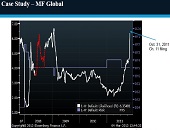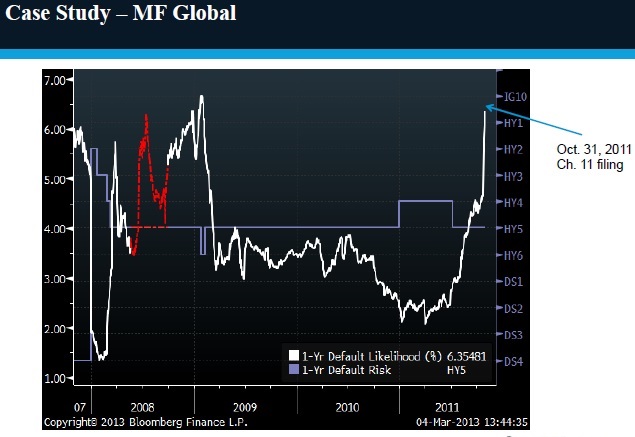“A quantitative model provides a very different insight than a rating,” said Rajan Singenellore, Global Business Manager of Risk & Valuations at Bloomberg. Models are based on objective inputs and usually publicly available information, whereas ratings are based on subjective factors and inside information.
Singenellore was speaking about quantitative models as the second part of a two-part webinar presentation “Monitoring Risk While Pursuing High Returns” on March 7, 2013 organized by the Global Association of Risk Professionals (GARP).
“A quantitative model lets you understand risk drivers and sensitivities,” he said, such as the effects of input changes on default risk in a scenario analysis. He briefly described the Bloomberg structural default model. It is a hybrid model that uses the firm’s income statement as well as the Black-Scholes-Merton framework.
“Relative value strategies can rapidly identify candidates for due diligence,” said Singenellore. As an example, he showed a plot of log Z spread versus log default probability (calculated using DRSK algorithms) where an outlier—calling out for further investigation—had been detected.
Singenellore showed a Bloomberg screen capture of “intrinsic value” vs. market value of a credit default swap (CDS). (Slide 24 in the presentation). “We usually find the market value to be more volatile” and the intrinsic value more stable.
The DRAM feature (Default Risk Aggregator and Monitor) can aggregate information by sector, portfolio, country, etc. “This allows risk to be ‘sliced and diced’ in a different manner,” he said. The aggregator could in the future use non-linear methods of combination, he said later in response to a question from the audience.
The C-Suite should pay attention to quantitative models, said Singenellore. A CFO of an unrated firm seeking access to capital markets would have a better idea how to position the firm if he or she knows the relative ranking of the firm compared to similar firms using the same model.
“How can we know how good the models are? How robust are they?” Singenellore chose two case studies. Default probability is consistent with accounting credit measures, CDS spreads, and the equity put implied CDS spread. He showed CDS spread profiles of two sobering cases: Lehman and MF Global, whose CDS spreads started rising well before the default, and skyrocketed in September 2008 and October 2011, respectively. (MF Global’s default risk is shown in the accompanying image.) “Even in the most stressful period, these models hold up well,” he concluded. These models provide good early warning of credit health problems.
A quantitative model is a highly useful risk management tool, he said. It can diagnose creditworthiness of counterparties and, when used to rank comparable firms, provides a quick means of identifying problem areas. ª
Go to Part 1. ª
The webinar presentation slides can be found at: http://www.garp.org/risk-news-and-resources/webcasts/on-demand-webcasts.aspx


